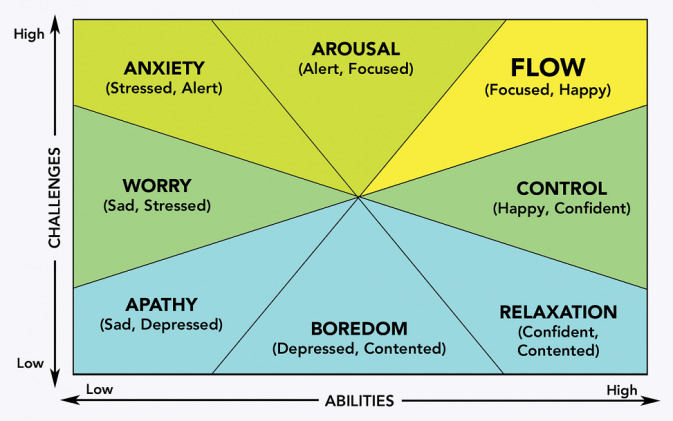“The best moments usually occur when a person’s body or mind is stretched to its limits in a voluntary effort to accomplish something difficult and worthwhile. Optimal experience is thus something we make happen.” -Csikszentmihalyi, 1990.
The theory of flow (also referred to as positive psychology) was developed by Hungarian psychologist Mihaly Csikszentmihalyi, as described in his 1990 book, Flow: The Psychology of Optimal Experience. Csikszentmihalyi defines flow as “the state in which people are so involved in an activity that nothing else seems to matter; the experience itself is so enjoyable that people will do it even at great cost, for the sheer sake of doing it.” In this state of being, people are motivated by inherent enjoyment of the challenges provided by the activity, and are subsequently more productive and happier. He identifies a number of different elements involved in achieving flow:
- There are clear goals every step of the way.
- There is immediate feedback to one’s actions.
- There is a balance between challenges and skills.
- Action and awareness are merged.
- Distractions are excluded from consciousness.
- There is no worry of failure.
- Self-consciousness disappears.
- The sense of time becomes distorted.
- The activity becomes an end in itself.
“A sense of that one’s skills are adequate to cope with the challenges at hand in a goal directed, rule bound action system that provides clear clues as to how one is performing. Concentration is so intense that there is no attention left over to think about anything irrelevant or to worry about problems. Self-consciousness disappears, and the sense of time becomes distorted. An activity that produces such experiences is so gratifying that people are willing to do it for its own sake, with little concern for what they will get out of it, even when it is difficult or dangerous.” – Csikszentmihalyi, 1991.
The metaphor of flow is one that many people have used to describe the sense of effortless action they feel in moments that stand out as the best in their lives. Athletes refer to it as “being in the zone,” advanced meditators and mystics extol it as a feeling of bliss, while artists and musicians describe it as “aesthetic rapture.” Athletes, meditators, and artists do different objective things to get into flow, but according to three decades of research with hundreds of thousands of people from all walks of life, the subjective experience is nearly identical. And, importantly, the fundamental dynamics of how the state is achieved are the same, regardless of the activity that facilitates it. There are four key dynamics that combine to create flow: 1. Balance between challenges and skills 2. Clear objectives 3. Frequent feedback 4. Focus and concentration (minimal distractions).
The experience of flow is possible under certain circumstances: when individuals find the activities challenging and also believe they have the skills to accomplish them. Optimal experience, or flow, occurs when a person perceives the challenges in a certain situation and the skills brought to it as both balanced and above average. Flow-inducing activities allow a person to focus on goals that are clear and compatible and provide immediate feedback. If challenges are too high, one gets frustrated, then worried, and eventually anxious. If challenges are too low relative to skills, one gets relaxed, then bored. If both challenges and skills are low, one feels apathetic. But if challenges are high and the requisite skills to meet those challenges are also high, one becomes fully engaged, deeply involved in the activity which makes flow likely to occur. The key drivers of flow are skill level and challenge level. A mismatch between those two drivers will not result in flow, and both have to be high in order to drive a person to perform at their highest level.

In particular, when individuals experience flow:
- Their goals are challenging but clear and attainable, aligning closely to their skills and abilities.
- They can readily ascertain their progress–that is, feedback is available and their behavior can thus be adjusted readily.
- Their focus is sharp and their concentration is intense.
- They do not feel at all self conscious.
- Any worries or anxieties tend to dissipate entirely.
- They experience a sense of control and agency.
- Their perception of time is distorted; that is, they underestimate the passage of time.
- Their activities seem intrinsically rewarding–that is, their tasks seem inherently interesting, called autotelic motivation.
- They experience a merging of action and awareness.
“There are two main strategies we can adopt to improve the quality of life. The first is to try making external conditions match our goals. The second is to change how we experience external conditions to make them fit our goals better.” – Csikszentmihalyi, 1990.